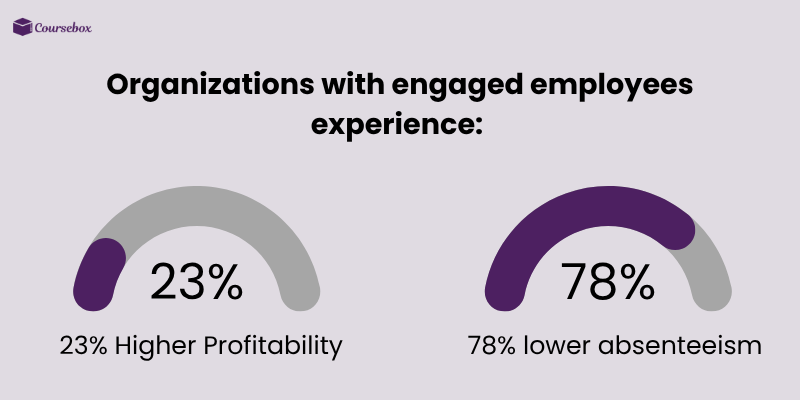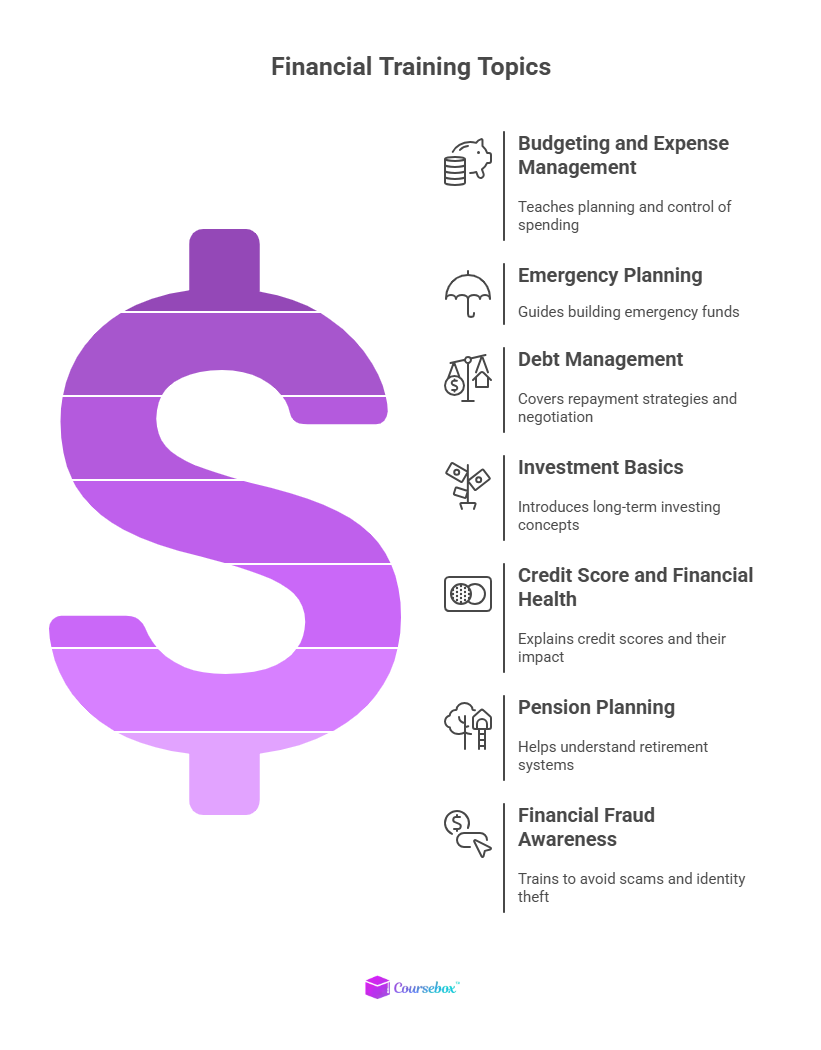5 Benefits of Financial Training for Employees
Are your employees making smart financial decisions? If not, here are the top five benefits of financial training for employees and how it boosts retention.
Are your employees making smart financial decisions? If not, here are the top five benefits of financial training for employees and how it boosts retention.

Did you know that 63% of employees report that financial stress impacts their work performance? And yet, most companies still expect their employees to make smart financial decisions without ever providing them with financial training.
This stress follows employees into meetings, affects their focus, reduces productivity, and increases absenteeism.
However, proper financial training for employees can change everything.
It teaches employees budgeting and savings, as well as builds confidence, reduces financial anxiety, and improves job performance.
In the next section, we’ll break down the five biggest benefits of financial training for employees and how it can transform your organization from the inside out.
Financial training is an effective training program that teaches employees how to understand, manage, and improve their personal finances. It equips employees with the practical skills they need to manage budgeting, saving, investing, and more.

The training is just as important as technical skills in today’s world. According to PwC’s Annual Employee Financial Wellness Survey, 57% of employees report that financial stress is their #1 distraction at work. The right financial training can help reduce this stress and allow employees to focus more thoroughly on their jobs.
Instead of leaving employees to figure out finances on their own, financial training for employees provides step-by-step guidance. You can deliver this training through:

Remember, financial training for employees doesn’t just teach “how money works.” It improves how they feel about money and how confidently they make decisions. When employees are financially secure, they become more productive, focused, and committed to their work.
Now, let’s break down the core benefits.

Financial stress doesn’t just affect someone’s wallet; it affects their brain’s ability to function and focus. When an employee is worried about debt, late payments, or running out of money before payday, they show up to work, but mentally, they are somewhere else.
In fact, a report by the American Psychological Association (APA) found that 72% of adults experience financial stress.

This stress directly impacts:
Financial training gives employees tools to plan, budget, save, and control their finances. Once employees learn to manage money rather than letting it manage them, stress decreases as uncertainty decreases.
Low stress = Better performance.
Employees who feel financially secure participate more actively at work and are more productive. They take initiative, collaborate better, and contribute more ideas because they aren’t mentally distracted.
Gallup reports that organizations with engaged employees experience 23% higher profitability and up to 78% lower absenteeism.

When financial training shows employees how to reach goals like:
They begin to feel hopeful about their future. People who feel hopeful show up differently, not just physically, but also emotionally and mentally. Additionally, training engagement improves because employees feel supported.
It’s surprising to see that financial literacy is only 50% in the U.S. and has decreased by 2% over the last 8 years. It also involves a majority of employees, who often don’t understand how to use their money wisely.

In contrast, employees who understand money make fewer mistakes with company assets. This matters especially in roles involving expense management, procurement, budgeting, or handling transactions.
Here, financial training for employees helps:
This enables employees to think strategically (“Is this the best use of money?”), and not act emotionally (“we need this now”) about it.
Better financial judgment = Fewer costly mistakes.
Most companies invest heavily in benefits, such as retirement plans, matching contributions, health insurance, and employee stock programs. Yet, many employees underuse them simply because they don’t understand them.
Studies show that only 36% of employees understand the benefits their companies offer them. This means that the other 67% of the employees miss out on free money or support, as they don’t understand their benefits.

In simple terms, financial training for employees explains how requirements work, how to maximize tax advantages, and how it reduces financial stress.
When employees understand their benefits, they use them. This makes them more financially stable, thus increasing their likelihood of staying longer. Now you see how this can also be an employee retention strategy to keep them engaged.
Financial training helps employees make better decisions about their personal finances and those that affect their work. When someone understands how money works, they become more thoughtful about planning, spending, and investing (such as in index funds).
They learn how to compare choices, consider long-term consequences, and assess whether an action is financially smart. After knowing financial concepts, employees think through decisions and choose what aligns best with their goals.
This skill transfers directly into workplace performance. Employees begin to manage budgets more responsibly, prepare better project estimates, and make choices based on logic rather than impulse.
As an organization, this shows you that financial training for employees makes them more resourceful and independent.

Financial training is a type of employee training program that equips employees with practical skills they can apply immediately in real life. The following topics form the foundation of an effective financial training program.
Budgeting is the foundation of financial stability. Employees who learn to plan and manage their monthly expenses gain control rather than react to financial pressure.
A budgeting module teaches employees how to track income, categorize expenses, and assign spending limits in a way that feels manageable. They learn to separate essential spending (rent, bills, groceries) from flexible spending (entertainment, eating out).
The goal is to help them understand that money must have a plan; otherwise, spending becomes emotional and impulsive. Budgeting training also introduces tools such as bank budgeting apps and spreadsheet templates that help employees monitor their spending each week.

An emergency fund protects employees from unexpected financial shocks, like medical expenses, car repairs, layoffs, or sudden family emergencies. Even a small crisis can trigger significant stress at work if employees have no safety gear.
That’s why teaching emergency planning is important. It shows employees how to calculate their ideal emergency fund (typically 3–6 months of expenses), where to store it, and how to build it gradually through automation.
This module introduces the concept of small weekly transfers into a high-yield savings account. Employees learn that consistency matters more than size. For instance, even $30 a week becomes $1,560 a year without effort.
It is one of the primary financial stress triggers for modern employees. Debt management training helps employees understand debt as a solvable problem and not something overwhelming.
Employees are taught how interest works and how repayment strategies can reduce their total debt significantly. There are two strategies introduced in this module:
This training module also teaches negotiation skills, like reducing interest rates through consolidation or requesting payment adjustments.
One thing to remember here is that investing is not about becoming rich overnight. It’s about understanding how money grows over time. Investment training helps employees shift from a saving-only mindset to a growing money mindset.
Many employees believe that investing is complicated, risky, or “only for wealthy people,” so training simplifies concepts such as stocks, ETFs, and other investment products.
Example: Someone who invests $200/month starting at age 25 can grow over $500,000 by age 65 with moderate returns.
The training also shows how to start investing with small amounts, even $50 per paycheck. It shows how to use employer-sponsored plans (such as 401(k)s, superannuation, etc.) to accelerate growth.

A credit score directly affects financial opportunities. This includes home loans, car financing, rentals, insurance rates, and even job applications in certain industries. Training teaches how credit scores are calculated (payment history, credit usage, account age) and how small habits make a big difference.
Through this, your employees will learn how to monitor their credit score, dispute incorrect records, and avoid behaviors that can damage their credit. They’ll also learn how credit utilization works, which is using less than 30% of your credit limits.
A strong credit score automatically means lower interest rates. And once employees understand this, they begin making more informed choices.
Retirement planning (such as superannuation) helps employees achieve long-term financial security. Most employees are unaware of how their employer's retirement system works, potentially missing out on free money.
This module explains retirement plans in simple terms. Moreover, your employees get to start early, which drastically reduces the amount they need to save later.
Training also covers compound growth and includes simple examples (e.g., “If you delay saving 10 years, you may need to save twice as much”).

Digital fraud and scams are now widespread, yet many employees remain unaware of them. As a matter of fact, the Federal Trade Commission (FTC) reported that consumers lost more than $10 billion to fraud in 2023. It’s the highest ever recorded in recent years.
This is why fraud awareness training is essential. It teaches employees how to identify phishing attempts, fake investment offers, scam emails, and risks of identity theft.
Training helps employees learn the signs of fraud, such as:
Fraud awareness also teaches individuals how to protect their personal financial accounts through the use of two-factor authentication and secure browsing habits.
Financial training for employees is one of the smartest investments a company can make. When employees understand how to manage their money, they appear more focused, more confident, and more committed to their work.
However, one major issue companies face is how to deliver that training. And that’s where Coursebox makes the process easier.
With it, you can turn any PDF into an AI-generated training video for employee training. Moreover, the platform provides employees with 24/7 support via an AI chatbot trained on your course.
You can start building your program today!

Financial training can be delivered using e-learning platforms, video lessons, microlearning modules, and interactive tools. Platforms such as Coursebox allow you to upload materials, automate training, and track employee progress. This makes financial learning structured, repeatable, and measurable without requiring manual follow-up from trainers.
Absolutely. Financial training benefits every employee, not just those in finance roles. It reduces stress, improves decision-making, and increases productivity by helping employees manage their money with confidence. When personal finances are stable, employees show better focus, performance, and engagement at work.
Most companies face no compliance issues when offering general financial education. Problems arise only if the training provides individualized investment advice or claims guaranteed earnings. Keeping the training educational and focused on financial literacy, budgeting, and benefit usage ensures legal safety.
Financial training costs vary by format. Instructor-led workshops cost $3,000 to $7,500 per session. Meanwhile, online platforms are more affordable, costing $5 to $25 per employee per month. To reduce long-term costs, you can use Coursebox’s AI LMS, which lets you reuse content and eliminates the need to pay instructor fees repeatedly.
